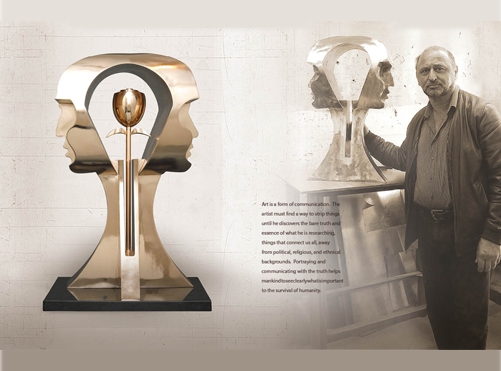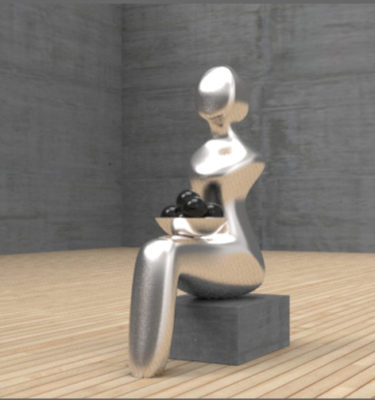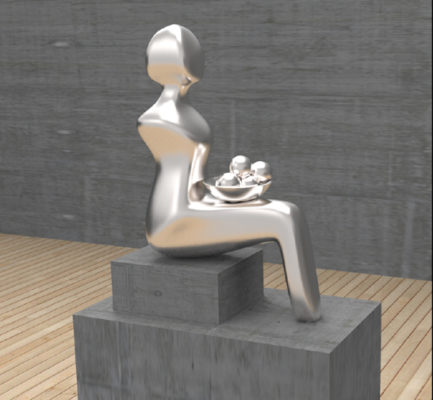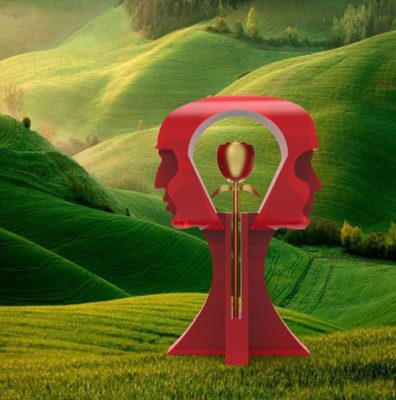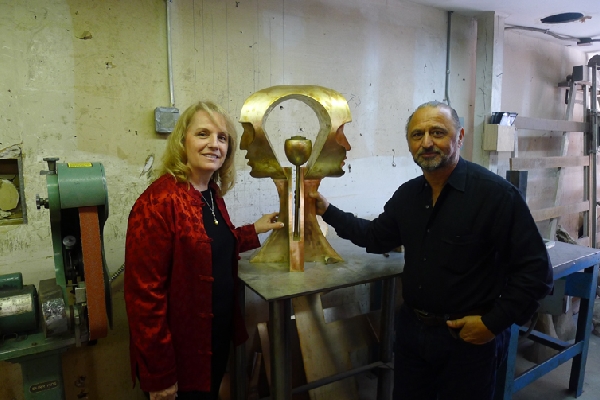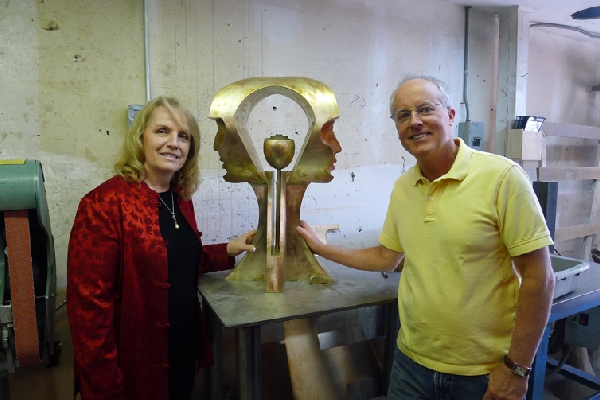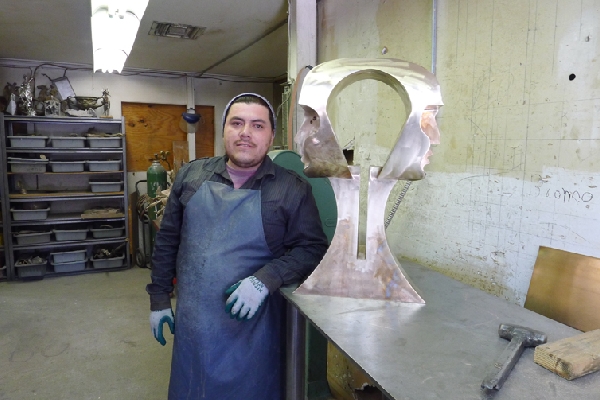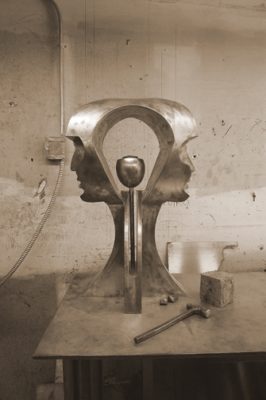Yuroz’s new sculptures emanate from a startling, theoretical futuristic voyage, traveling at the speed of light into the distant future of art while recollections of the past are put behind us as they fade into the category of artistic impressions that once stood the test of time, but are now relegated to a dusty archive of perceptible chronology.What is so remarkable about this series of metallic works is that there does not appear to be any decipherable DNA to connect them with an identifiable art movement or actual artist. The objects seem to have dropped into our psyche without warning and without the courtesy of a proper introduction, which is certainly part of the excitement, like the immediate sighting of a familiar face at a crowded opening.
New sculpture collection
After years of experimentation and exploration of abstracting the figure, Yuroz appears to have deliberately stumbled across a truly unique approach that has not been seen before. While it might be difficult to assign this series to a specific category, these latest works certainly can be described as both evolutionary and revolutionary. It always has been the nature of a true artist to strive for a fresh approach to art-making, and it has been obvious in breakthrough methods of history-making artists like Braque, Cezanne and Picasso; Juan Gris (analytical cubism); and later, with the completely ingenious spirit of de Kooning. The late great British sculptor, Henry Moore, also was a controversial innovator who began breaking down the human form, which he often pictured reclining, into areas of smooth abstraction where narrative components nearly disappear into graceful patinaed bronzes that offer a delicate balance between the distinguishable and the undecipherable. The common denominator that the Los Angeles-based artist Yuroz shares with these “rebels” is that their distinctive and celebrated treatment of space, volume and mass has been deliberately homogenized into a multitude of viewpoints (instead of one) to convert a classic subject into a greater context. Illusion can certainly be created on a two-dimensional plane, which Yuroz obviously has mastered during his illustrious career, but the value of reassembling an artist’s conception into streamlined sculpture allows for a complete solid mass expansion of one’s idiosyncratic vision. Yuroz also has a particular advantage in expanding his ideas into three-dimensional shapes, because he has a strong academic background in architecture and fine arts. With that unusual point of view, he is able to secure an unprecedented genre with a unified style, highly polished and simplified with classical aerodynamic proportions.
These qualities relate back to modernist architecture that commemorates a design that refers to the past but is reoriented toward a brand new vision. The key to Yuroz’s original technique, which is pleasantly available to a wide audience, is his intelligent reduction of details. So much so, that the abstracted object of a figure magically evaporates almost to the point of minimum recognizability. The intellectual simplification of the basics, such as cylinders, spheres and cones (the building blocks of the figure), has been a constant challenge in modern art. Finding a “new passage” that goes beyond conventional sculpture with precision cuts and reduced visual evidence was the key in the historic progression of contemporary art. Yuroz seems to grab the baton and run with it to a level of invention not thought possible.
Throughout time, artists have pursued a creative course that often was influenced by historical masters of their individual discipline. The evolution of sculpture can be traced back to primitive man, who first attempted to recreate his own likeness by painting on cave walls, and slowly but surely matured into employing an arguably more challenging medium, which required a solid material like wood or stone that could be chipped, sliced or even burned away until a decipherable likeness appeared.Ironically, it was the influence of African tribal masks that were methodically articulated from a piece of rough wood with primitive carving tools that unknowingly and accidentally exposed the concept of applicable abstraction to twentieth century masters like Picasso, who enthusiastically appropriated this centuries old method of transforming a piece of organic material into spirited and recognizable portraiture.
Yuroz travels back in time in order to move into the future, while subconsciously gathering as the foundation for his novel works the most fundamental metaphorical models of abstraction that are ingeniously hidden. These elements act as powerful, shiny, harmonious instruments paying homage to the seminal simplicity of early cultures, which were reduced into logical processes of architectonic structure that morphs into a humanoid appearance. Instead of using traditional studio craftsmanship derived from tools such as a chisel or a carving knife, Yuroz has successfully harnessed modern technology that replaces a drawing board or a plaster maquette with electronic software tools, which opens a completely different horizon and offers the artist an endless array of applications to support and enlighten his sensibilities. With these magical benefits, the creative mind is free to wander in all directions, utilizing unexpected discoveries and even making the most out of surprising technological ‘accidents’ that present literally unlimited possibilities to generate things that would not be conceivable under traditional circumstances.
Courageous artists are always on the hunt for expanding their palette and pushing their own creativity into diverse paths. The upcoming survey of Italian Futurism at the Guggenheim Museum is a case in point that comfortably fits into the constructivist attitudes that surface in Yuroz’s breakthrough developments. This noteworthy movement captured a fascination with futuristic flowing shapes, from sculpture to automobiles and even appliances, which radically influenced generations of artists to come. Yuroz’s works may take a cue and a measure of security from these innovative pioneers, and he advances his own “test drive” into the great unknown with sculptural forms that seem as though they are laboratory designs for handsome, wind resistant vehicles that integrate singular style with practicality. His recent series of sculptures, specifically “seated woman,” reminds one of an indestructible female, not completely human, nearly post-human, as if this is what we might evolve into hundreds of years into the future.This elegant piece is reminiscent of Metropolis, and even a bit like the iconic, polished silver hood ornament on a Rolls-Royce. One may feel compelled to bow down to this enchanted creature, or perhaps fear it, as it suddenly was placed at an urban crossroad by some alien force, like a high-tech Trojan horse. Other works in this group share satisfying characteristics of style, scale and compositional proportions. Perhaps the most thrilling aspect of this collection is anticipating what will Yuroz come up with next?

